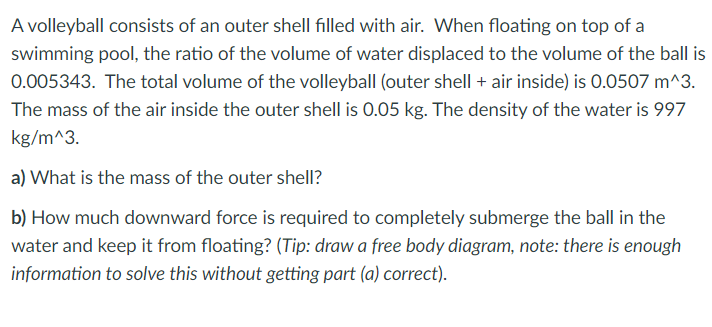A volleyball consists of an outer shell filled with air. When floating on top of a swimming pool, the ratio of the volume of water displaced to the volume of the ball is 0.005343. The total volume of the volleyball (outer shell + air inside) is 0.0507 m^3. The mass of the air inside the outer shell is 0.05 kg. The density of the water is 997 kg/m^3. a) What is the mass of the outer shell? b) How much downward force is required to completely submerge the ball in the water and keep it from floating? (Tip: draw a free body diagram, note: there is enough information to solve this without getting part (a) correct).
A volleyball consists of an outer shell filled with air. When floating on top of a swimming pool, the ratio of the volume of water displaced to the volume of the ball is 0.005343. The total volume of the volleyball (outer shell + air inside) is 0.0507 m^3. The mass of the air inside the outer shell is 0.05 kg. The density of the water is 997 kg/m^3. a) What is the mass of the outer shell? b) How much downward force is required to completely submerge the ball in the water and keep it from floating? (Tip: draw a free body diagram, note: there is enough information to solve this without getting part (a) correct).
College Physics
10th Edition
ISBN:9781285737027
Author:Raymond A. Serway, Chris Vuille
Publisher:Raymond A. Serway, Chris Vuille
Chapter9: Solids And Fluids
Section: Chapter Questions
Problem 24P
Related questions
Question

Transcribed Image Text:A volleyball consists of an outer shell filled with air. When floating on top of a
swimming pool, the ratio of the volume of water displaced to the volume of the ball is
0.005343. The total volume of the volleyball (outer shell + air inside) is 0.0507 m^3.
The mass of the air inside the outer shell is 0.05 kg. The density of the water is 997
kg/m^3.
a) What is the mass of the outer shell?
b) How much downward force is required to completely submerge the ball in the
water and keep it from floating? (Tip: draw a free body diagram, note: there is enough
information to solve this without getting part (a) correct).
Expert Solution
This question has been solved!
Explore an expertly crafted, step-by-step solution for a thorough understanding of key concepts.
This is a popular solution!
Trending now
This is a popular solution!
Step by step
Solved in 2 steps with 2 images

Knowledge Booster
Learn more about
Need a deep-dive on the concept behind this application? Look no further. Learn more about this topic, physics and related others by exploring similar questions and additional content below.Recommended textbooks for you

College Physics
Physics
ISBN:
9781285737027
Author:
Raymond A. Serway, Chris Vuille
Publisher:
Cengage Learning

Principles of Physics: A Calculus-Based Text
Physics
ISBN:
9781133104261
Author:
Raymond A. Serway, John W. Jewett
Publisher:
Cengage Learning

Physics for Scientists and Engineers with Modern …
Physics
ISBN:
9781337553292
Author:
Raymond A. Serway, John W. Jewett
Publisher:
Cengage Learning

College Physics
Physics
ISBN:
9781285737027
Author:
Raymond A. Serway, Chris Vuille
Publisher:
Cengage Learning

Principles of Physics: A Calculus-Based Text
Physics
ISBN:
9781133104261
Author:
Raymond A. Serway, John W. Jewett
Publisher:
Cengage Learning

Physics for Scientists and Engineers with Modern …
Physics
ISBN:
9781337553292
Author:
Raymond A. Serway, John W. Jewett
Publisher:
Cengage Learning

Physics for Scientists and Engineers
Physics
ISBN:
9781337553278
Author:
Raymond A. Serway, John W. Jewett
Publisher:
Cengage Learning

Physics for Scientists and Engineers: Foundations…
Physics
ISBN:
9781133939146
Author:
Katz, Debora M.
Publisher:
Cengage Learning

Physics for Scientists and Engineers, Technology …
Physics
ISBN:
9781305116399
Author:
Raymond A. Serway, John W. Jewett
Publisher:
Cengage Learning